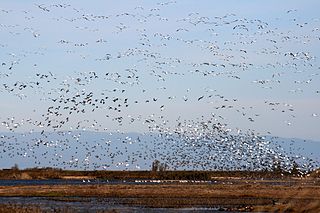
The Sacramento National Wildlife Refuge Complex is part of the United States system of National Wildlife Refuges (NWR). It is located in northern California, in the valley of the Sacramento River.

Sea Rim State Park is a 4,141-acre (1,676 ha) state park in southeast Texas. The park is located on the Gulf of Mexico in southern Jefferson County, south of Port Arthur and just west of Sabine Pass. The park was closed for several years due to extensive damage from Hurricanes Rita (2005) and Ike (2008). The park has recently re-opened but currently has limited resources.

Sabine National Wildlife Refuge is a National Wildlife Refuge of the United States located in Cameron Parish in southwestern Louisiana. It is on Louisiana State Route 27, 8 miles (13 km) south of Hackberry and 12 miles (19 km) north of Holly Beach. The western boundary of the Sabine Refuge is Sabine Lake, the inlet for Port Arthur, Texas, while the tip of the eastern end reaches Calcasieu Lake.

The Okefenokee National Wildlife Refuge is a 402,000‑acre (1,627 km2) National Wildlife Refuge located in Charlton, Ware, and Clinch Counties of Georgia, and Baker County in Florida, United States. The refuge is administered from offices in Folkston, Georgia. The refuge was established in 1937 to protect a majority of the 438,000 acre (1,772 km2) Okefenokee Swamp. The name "Okefenokee" is a Native American word meaning "trembling earth."
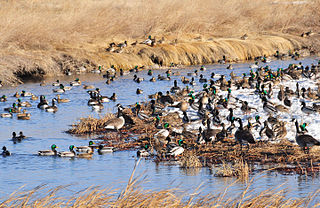
Lacreek National Wildlife Refuge is a National Wildlife Refuge of the United States located in South Dakota. It covers 16,410 acres (66.4 km2) and is managed by the United States Fish and Wildlife Service.
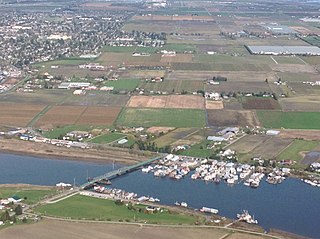
Westham Island is an island located near Ladner, British Columbia, Canada within the municipality of Delta, which in turn is part of Greater Vancouver. The George C. Reifel Refuge for migratory birds is located at the northern end of the island. The Alaksen National Wildlife Area is also located on the island. The island is accessible via the Westham Island Bridge
The Mark Twain National Wildlife Refuge Complex was established for the protection of migratory birds including waterfowl, shorebirds, and songbirds. It is located along the Mississippi Flyway, one of the major routes for migrating waterfowl. Refuge units also provide important habitat for big-river fish and a variety of other native wildlife such as deer, fox, beaver, frogs, turtles, and snakes. Key goals are to conserve and enhance the quality and diversity of fish and wildlife and their habitats, to restore floodplain functions in the river corridor, and to provide wildlife-related recreational experiences for the public.

The J. N. "Ding" Darling National Wildlife Refuge is part of the United States National Wildlife Refuge System, located in southwestern Florida, on Sanibel Island in the Gulf of Mexico. "Ding" Darling Wildlife Society (DDWS), a non-profit Friends of the Refuge organization, supports environmental education and services at the J.N. "Ding" Darling National Wildlife Refuge. It is named for the cartoonist Jay Norwood "Ding" Darling.

The Caloosahatchee National Wildlife Refuge is part of the United States National Wildlife Refuge System, located on the Caloosahatchee River, beneath the I-75 Caloosahatchee Bridge, within the city of North Fort Myers. The 40-acre (160,000 m2) refuge was established on January 1, 1921. It is administered as part of the J.N. 'Ding' Darling National Wildlife Refuge Complex.

The Matlacha Pass National Wildlife Refuge is part of the United States National Wildlife Refuge System, located within the Matlacha Pass estuary, approximately 8 miles northwest of Cape Coral, Florida. The 538 acre (2.2 km2) refuge was established on September 26, 1908. It is administered as part of the J.N. 'Ding' Darling National Wildlife Refuge Complex.

The Pine Island National Wildlife Refuge is part of the United States National Wildlife Refuge System, located on the southwest coast of Florida south of Charlotte Harbor, north of Sanibel Island in Pine Island Sound on La Costa Island. The 601-acre (2.43 km2) refuge was established on September 15, 1908. It is administered as part of the J.N. 'Ding' Darling National Wildlife Refuge Complex.
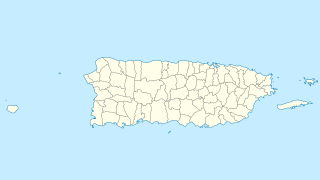
Cabo Rojo National Wildlife Refuge is located on the southwestern side of Puerto Rico in the municipio of Cabo Rojo. It was established in 1974, when 587 acres of land were obtained by the U.S. Fish and Wildlife Service from the Central Intelligence Agency which had operated the Caribbean Bureau of the Foreign Broadcast Information Service there for a number of years. The 1,836 acres (7.43 km2) refuge is a habitat for number of native bird species including the endangered yellow-shouldered blackbird also known as la mariquita de Puerto Rico or capitán. Many birds find their way to the refuge while migrating between North and South America.

The Kirtlands Warbler Wildlife Management Area is administered by the United States Fish and Wildlife Service, and is located in northern Lower Michigan.
Brumba National Wildlife Refuge is a National Wildlife Refuge in Towner County, North Dakota. It is managed under Devils Lake Wetland Management District.

San Diego Bay National Wildlife Refuge is an urban refuge located on San Diego Bay in San Diego County, California. It is part of the San Diego National Wildlife Refuge Complex. It was dedicated in June 1999.

San Diego National Wildlife Refuge is a National Wildlife Refuge in California. It is part of the San Diego National Wildlife Refuge Complex.
The Big Island National Wildlife Refuge Complex is a protected wildlife refuge administered by the U.S. Fish and Wildlife Service located on Hawaiʻi Island in the state of Hawaii. It consists of Hakalau Forest on the windward side of Mauna Kea and Kona Forest on the western side of Mauna Loa.
Chesapeake Marshlands National Wildlife Refuge Complex is a National Wildlife Refuge complex in the state of Maryland located near the Delmarva Peninsula.
Long Island National Wildlife Refuge Complex is a National Wildlife Refuge complex in the state of New York. All of the component refuges are located on Long Island.
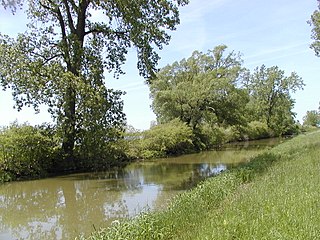
Ottawa National Wildlife Refuge Complex is a National Wildlife Refuge complex in the state of Ohio.















